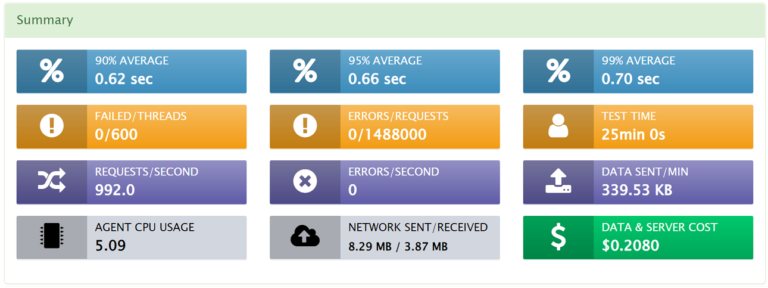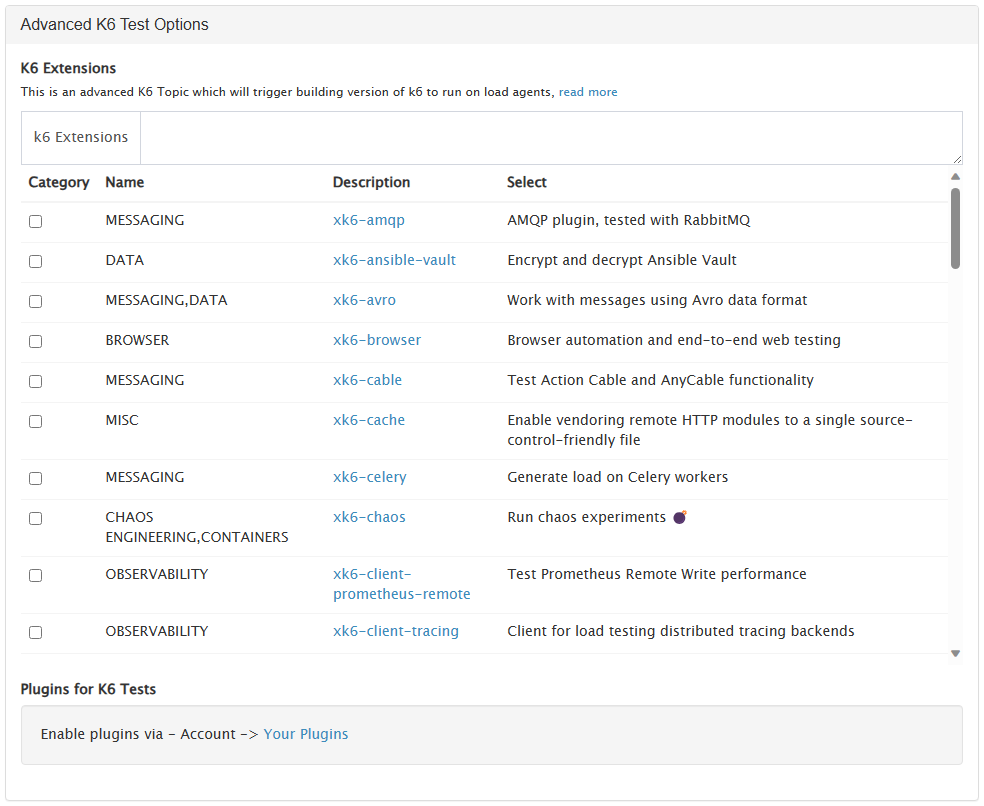RedLine13 gives you the ability to run your k6 tests in the cloud. All of the details in setting up k6 are handled behind the scenes, so running your k6 tests on our platform is as simple as filing out only a few basic details and clicking “Start Test“.
Getting Started
To run a k6 test on RedLine13, begin by logging into your account, clicking on “Start Test“, and then navigating to the “k6” tab:

Running Your First k6 Test
The first thing you will need to have prepared is your k6 test plan. Typically, this will be a JavaScript (*.js) file. Once you have your prepared test plan file, you can then configure your test on RedLine13:

- Upload your k6 simulation file (i.e., *.js file).
- Specify the number of load generator servers you wish to run your test from.
- Upload any attachments (e.g., CSV files) as “Extra Files“.
- Click on “Start Test“.
Viewing Results for Your Test
As your test begins, real time results will be displayed on the load test results page. These tables and graphs will update and finalize at the conclusion of your test. In addition to this, a test summary will be displayed after your test completes containing the most pertinent test information. Below is an example which is also covered in our documentation in more detail under “Test Summary“:

Field Descriptions
| Field | Description |
| Upload k6 | This is where you can upload your k6 test plan file containing your load test. Typically, this will be a JavaScript (*.js) file. |
| Number of Servers | This will be the number of load agents (i.e., servers in AWS running your test plan). Each server will run your test plan in parallel. |
CSV Data and Compressed Archives in Extra Files
Any custom load test supports extra files, with CSV files and compressed archive having special context. When a CSV file is uploaded, there is an option to “split” that file across all load generators. This works by dividing the file as evenly as possible (by whole line) with each load generator getting a different fragment of the file.
Compressed files (*.tar, *.tar.gz, and *.tgz) can either be uploaded in their compressed form or marked to be expanded after being uploaded to each load generator.
Save Response Output and Calculate Percentiles
You may notice a checkbox option when running your k6 test that is labeled “Save Response Output and Calculate Percentiles“. If you tick this box, our systems will collect and store log files for your test. In addition, we will also parse your load test data to calculate and display percentiles information.

Advanced Cloud Options
This section will be available when you have integrated with AWS. Though AWS integration with RedLine13 is not required, it unlocks the greatest potential for scaling your load tests. The default instance size for load generators is m6i.large, and if no other configuration changes are needed beyond AWS defaults within your account this may suit your testing needs just fine. However you can fine tune load generator server type and properties to best match your test plan requirements. This will enable you to run your load test with maximal cost efficiency and also ensure that each load generator has the proper resources it needs to execute your test. A survey of the most pertinent advanced cloud options fields is as follows:
| Field | Description |
| Location | The options listed here correspond to AWS regions where your load generators will originate from. This field is required (with the default being US-East-1) however multiple regions can be configured for the same test, if desired. |
| Number of Servers | This will be the number of load agents (i.e., servers in AWS running your test plan). Each server will run your test plan in parallel. If this setting is changed here, it will also be updated above under the general test options. |
| Size | This is the AWS EC2 virtual machine size (with the default value being m3.medium). You can select a larger or smaller instance size to adjust for required capability for your test. |
| Disk Size | Each load generator is a virtual machine with a logical disk. The default disk size is 16GB and depending on the requirements of your test you may need to increase this size. |
| Subnet ID | If the load generator EC2 instance requires a subnet to be specified, you can select it from this drop down list. |
| Security Group ID | If your test requires a custom security group to be specified, you can do so using this field. |
Advanced k6 Test Options
RedLine13 extends several advanced options when running k6 tests on our platform. One feature is k6 extensions, which allow your load test to leverage libraries with added functionality available through the k6 extension ecosystem. In addition, the advanced options section allows you to utilize test plugins that you have enabled within your RedLine13 account.

